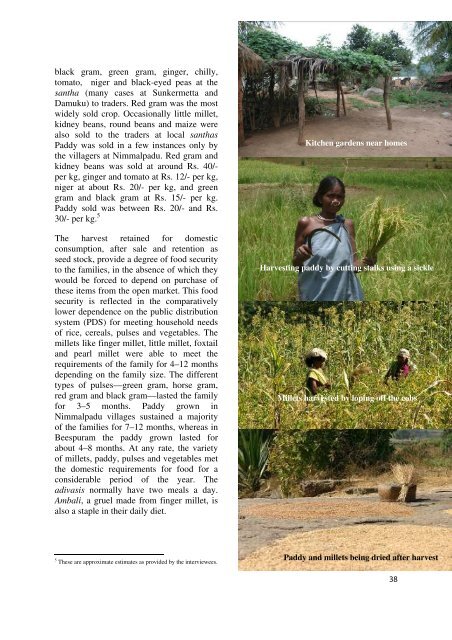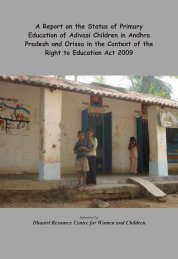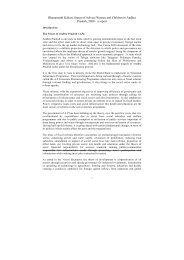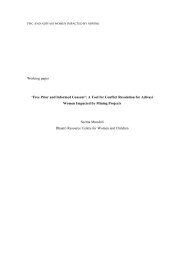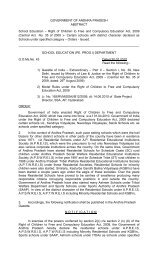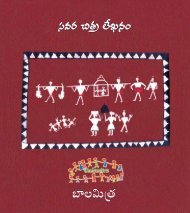Impacts of Government Policies on Sustenance of Tribal ... - Samata
Impacts of Government Policies on Sustenance of Tribal ... - Samata
Impacts of Government Policies on Sustenance of Tribal ... - Samata
You also want an ePaper? Increase the reach of your titles
YUMPU automatically turns print PDFs into web optimized ePapers that Google loves.
lack gram, green gram, ginger, chilly,tomato, niger and black-eyed peas at thesantha (many cases at Sunkermetta andDamuku) to traders. Red gram was the mostwidely sold crop. Occasi<strong>on</strong>ally little millet,kidney beans, round beans and maize werealso sold to the traders at local santhasPaddy was sold in a few instances <strong>on</strong>ly bythe villagers at Nimmalpadu. Red gram andkidney beans was sold at around Rs. 40/-per kg, ginger and tomato at Rs. 12/- per kg,niger at about Rs. 20/- per kg, and greengram and black gram at Rs. 15/- per kg.Paddy sold was between Rs. 20/- and Rs.30/- per kg. 5The harvest retained for domesticc<strong>on</strong>sumpti<strong>on</strong>, after sale and retenti<strong>on</strong> asseed stock, provide a degree <str<strong>on</strong>g>of</str<strong>on</strong>g> food securityto the families, in the absence <str<strong>on</strong>g>of</str<strong>on</strong>g> which theywould be forced to depend <strong>on</strong> purchase <str<strong>on</strong>g>of</str<strong>on</strong>g>these items from the open market. This foodsecurity is reflected in the comparativelylower dependence <strong>on</strong> the public distributi<strong>on</strong>system (PDS) for meeting household needs<str<strong>on</strong>g>of</str<strong>on</strong>g> rice, cereals, pulses and vegetables. Themillets like finger millet, little millet, foxtailand pearl millet were able to meet therequirements <str<strong>on</strong>g>of</str<strong>on</strong>g> the family for 4–12 m<strong>on</strong>thsdepending <strong>on</strong> the family size. The differenttypes <str<strong>on</strong>g>of</str<strong>on</strong>g> pulses—green gram, horse gram,red gram and black gram—lasted the familyfor 3–5 m<strong>on</strong>ths. Paddy grown inNimmalpadu villages sustained a majority<str<strong>on</strong>g>of</str<strong>on</strong>g> the families for 7–12 m<strong>on</strong>ths, whereas inBeespuram the paddy grown lasted forabout 4–8 m<strong>on</strong>ths. At any rate, the variety<str<strong>on</strong>g>of</str<strong>on</strong>g> millets, paddy, pulses and vegetables metthe domestic requirements for food for ac<strong>on</strong>siderable period <str<strong>on</strong>g>of</str<strong>on</strong>g> the year. Theadivasis normally have two meals a day.Ambali, a gruel made from finger millet, isalso a staple in their daily diet.Kitchen gardens near homesHarvesting paddy by cutting stalks using a sickleMillets harvested by loping <str<strong>on</strong>g>of</str<strong>on</strong>g>f the cobs5 These are approximate estimates as provided by the interviewees.Paddy and millets being dried after harvest38


